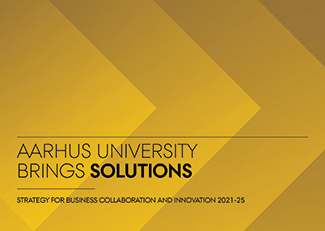Aarhus University brings solutions – new strategy for business collaboration and innovation 2021-25 approved
Aarhus University must make a greater and stronger impression on society. To support this goal, the senior management team approved a new sub-strategy for business collaboration and innovation 2021-25 at a meeting on 28 April. The sub-strategy is based on Aarhus University's Strategy 2025, which describes collaboration as one of the three pillars on which the university stands, along with research and education.

With this strategy, Aarhus University will now focus its contributions to addressing local and global challenges through research contributions to business and industry, public institutions and civil society: the university will creating more research-based companies and equip its graduates for the labour market of the future.
In short, the strategy aims to increase Aarhus University's contribution to growth and development in society. And the adoption of the strategy is just the beginning.
Now it’s time to put our fine words into action, and in this regard the Business Committee, on which all of the faculties are represented, has an important role to play. Because the foundation for the initiative is our research and teaching programmes, where new knowledge is created,” said Lone Ryg Olsen, director of enterprise and innovation.
The initiatives in the sub-strategy – entitled ‘Aarhus University brings solutions’ – are are divided into three main areas.
One of these focus areas is collaboration with industry, public institutions and civil society. Aarhus University has a long tradition of contributing through strong collaborations, but with the new sub-strategy, the ambition is to establish an even better framework for the creation of more concrete and mutually value-generating collaborations between researchers, students and companies, public institutions and civil society, and not least to ensure that society has access to the right highly specialised manpower.
The university must contribute new companies and innovative new solutions to society, which is the second main focus area covered by the sub-strategy. More students and researchers need to establish startups and spinouts, and more need to try their hand at entrepreneurship and innovation during their time at the university.
For this reason, the third main focus area is to strengthen business collaboration and innovation infrastructure internally at the university, so that researchers and students have access to the best facilities, knowledge about entrepreneurship and access to guidance, etc.
Prior to the strategy's approval, both external partners and leaders and employees at the university were involved in the strategy development process. When the strategy was submitted for consultation, Enterprise and Innovation, which spearheaded the strategy process, received a large number of consultation responses from all parts of the university. This feedback was incorporated into the strategy wherever possible.